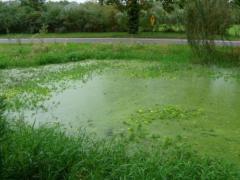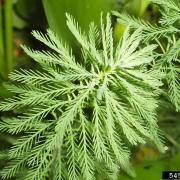Invasive Species: Myriophyllum aquaticum, Parrotfeather Watermilfoil
Parrotfeather watermilfoil is an herbaceous, rooted, submerged/emergent plant that invades aquatic habitats throughout much of the United States. Stems are stout and blue-green in color. Leaves are abundant, whorled, pinnately compound, and finely dissected. Submersed leaves are 0.6 to 1.4 in. (1.5 to 3.5 cm) long and have 20 to 30 divisions per leaf. Emergent leaves are 0.8 to 2 in. (2 to 5 cm) long, less divided, and greener than the submersed leaves. As only female plants occur in North America, reproduction occurs vegetatively. Inconspicuous flowers are formed in the axils of the emergent leaves in the spring (sometimes fall). Parrotfeather watermilfoil is found in lakes, ponds, and slow-moving streams where it can form dense mats of vegetation. These mats can clog waterways, impede boating traffic, disrupt the growth of native vegetation and provide a breeding ground for mosquitoes. Parrotfeather watermilfoil is native to South America and was first introduced into the United States in the Washington D.C. area around 1890 as an aquarium and aquatic garden plant.
What are invasive species and why should we be concerned about them?
Taxonomy: Scientific and Common Names for This Species
Haloragales > Haloragaceae > Myriophyllum aquaticum (Vell.) Verdc.
Synonym(s): water-feather, Brazilian water-milfoil, parrotfeather
Myriophyllum aquaticum – USDA PLANTS Profile
Distribution Maps
Parrotfeather watermilfoil – The reported distribution of this invasive species across the United States (Source: Invasive Plant Atlas of the United States)
Up-to-the-minute distribution maps and why they are important
Reporting This Invasive Species
What is the best way and place to report the occurrence of an invasive species?
How to report an invasive species sighting to EDDMapS – Early Detection & Distribution Mapping System
EDDMapS – Report an invasive species to EDDMapS.
Cooperative Extension Offices – Find your local Cooperative Extension office on this map provided by USDA.
How to Identify
This invasive species can be identified by looking for the characteristics described in the paragraphs that follow.
Plant
Herbaceous, rooted, submerged to emergent plant. Stems are stout and blue-green in color.
 |
 |
| Leslie J. Mehrhoff, University of Connecticut, Bugwood.org | Leslie J. Mehrhoff, University of Connecticut, Bugwood.org |
Foliage
Leaves are abundant, whorled, pinnately compound, and finely dissected. Submersed leaves are 0.6 to 1.4 in. (1.5 to 3.5 cm) long and have 20 to 30 divisions per leaf. Emergent leaves are 0.8 to 2 in. (2 to 5 cm) long, less divided, and greener than the submersed leaves.
|
|
 |
| Leslie J. Mehrhoff, University of Connecticut Bugwood.org |
Leslie J. Mehrhoff, University of Connecticut, |
Flower
As only female plants occur in North America, reproduction occurs vegetatively. Inconspicuous flowers are formed in the axils of the emergent leaves in the spring (sometimes fall).
| bugwood.org | bugwood.org |
Fruit
No fertile fruit is known to be produced in the United States.
| bugwood.org | bugwood.org |
Native Species That Can Resemble Parrotfeather Watermilfoil
– Images at invasive.org
| bugwood.org | bugwood.org |
– Images at invasive.org
| bugwood.org | bugwood.org |
Additional Images for Parrotfeather Watermilfoil
Parrotfeather watermilfoil – Images at Invasive.org
Learning Resources for Parrotfeather Watermilfoil
Myriophyllum aquaticum Identification Card – US Fish & Wildlife Service
Myriophyllum aquaticum Fact Sheet – US Fish & Wildlife Service
Additional Information, Biology, Control and Management Resources
Control and management recommendations vary according to individual circumstances. Location, habitat, weather, and a variety of other conditions are factors that help determine the best treatment choice. To find the safest and most effective treatment for your situation, consult your state’s land-grant institution. If you will use chemicals as part of the control process, always refer to the product label.
United States Land-Grant University System – Find your land-grant university’s college of agriculture, Cooperative Extension office, or other related partner on this map provided by USDA.
Plant Invaders of Mid-Atlantic Natural Areas – National Park Service and US Fish and Wildlife Service
Invasive Plant Atlas of New England – University of Connecticut
Global Invasive Species Database – Invasive Species Specialist Group
Plant Profiles – Cal-IPC
Center for Aquatic and Invasive Plants – University of Florida IFAS
Invasive Plant Atlas of New England – University of Connecticut
Plant Invaders of Mid-Atlantic Natural Areas – USDA Forest Service & USDA APHIS PPQ

